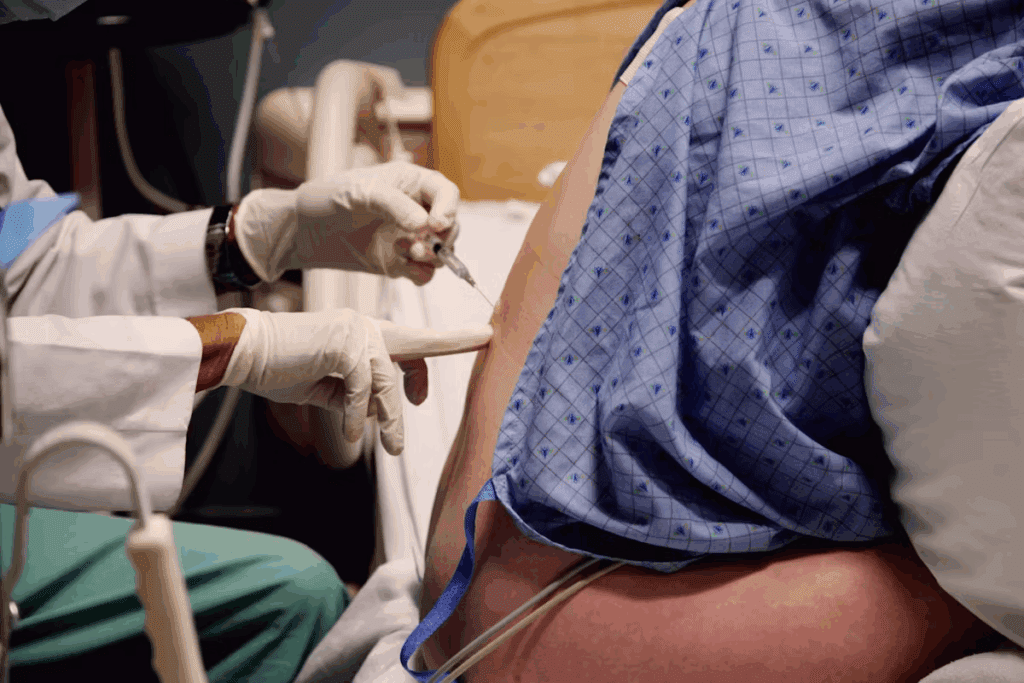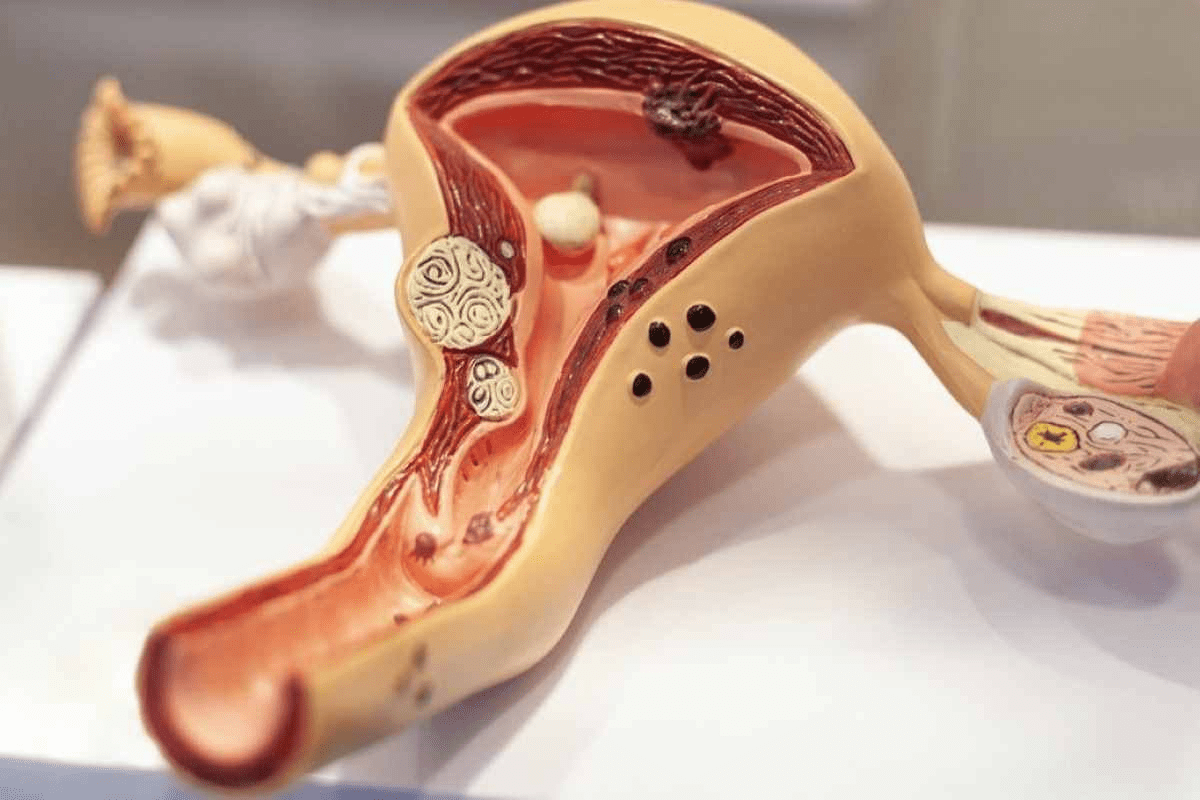Last Updated on November 26, 2025 by Bilal Hasdemir

At Liv Hospital, we aim to provide top-notch healthcare. If you or a loved one is looking into treatments for degenerative disc disease, it’s key to know about the latest in spinal injections.
We focus on international medical standards. Our team is skilled in epidural injections, helping patients with advanced disease live better. We offer safe, effective, and current spinal treatments.
Considering epidural injections for degenerative disc disease? Learn 7 key facts about their effectiveness, risks, and frequency.
We combine top expertise with care focused on the patient. Our goal is to lessen pain and boost function in those with severe degenerative disc disease.
Key Takeaways
- Understanding the latest advancements in spinal injections is key for treating degenerative disc disease.
- Epidural injections can greatly enhance life quality for those with advanced disease.
- Liv Hospital is dedicated to delivering world-class healthcare with full international patient support.
- Our team offers safe, effective, and current spinal treatments.
- Patient-centered care is at the core of our treatment approach.
Understanding Degenerative Disc Disease and Its Impact

Understanding degenerative disc disease is key for those with chronic back pain and limited mobility. We see how important this condition is for patients’ lives.
What Happens to Discs as They Degenerate
As degenerative disc disease gets worse, spinal discs change a lot. The discs lose their height and flexibility. This makes them less able to cushion the vertebrae.
This can cause the disc to bulge or herniate. This can irritate nearby nerves and cause pain.
This process can take years, happening as people age. It affects millions worldwide, causing a lot of disability.
Common Symptoms and Their Effect on Quality of Life
Symptoms of degenerative disc disease vary. Common ones are chronic back pain, stiffness, and limited mobility. These symptoms can really affect a patient’s life, making simple tasks hard.
We aim to help international patients. We guide them through treatment options to improve their well-being. Understanding the degeneration process helps us see how treatments like epidural injections can help manage the disease.
The Role of Epidural Injections for Degenerative Disc Disease

Epidural injections are key in treating degenerative disc disease. At our institution, we aim to provide top-notch healthcare. Epidural injections are a big part of our treatment plan for this disease.
These injections help manage pain from degenerative disc disease. Studies show they can greatly reduce pain. This improves patients’ quality of life.
How Injections Target Pain Sources
Epidural injections aim at the pain source in degenerative disc disease. They deliver medicine right next to the spinal cord. This method targets the pain area effectively.
The injections mix corticosteroids and local anesthetics. Corticosteroids reduce inflammation, a common pain cause. Local anesthetics numb the area, giving quick pain relief.
When Injections Are Recommended in the Treatment Journey
Doctors suggest epidural injections when other treatments don’t work. Our team considers them for patients who haven’t seen improvement.
Choosing to get epidural injections depends on a patient’s condition. We use diagnostic imaging like MRI to target the pain source. This makes the injections more effective.
Knowing about epidural injections helps patients make better treatment choices. Our team is dedicated to giving full care. We guide patients through their treatment journey.
Types of Injections Used for Disc Problems
Several injection types are key in managing disc pain. Our institution offers care for international patients, tailoring treatments to each person’s needs. We use epidural steroid injections and trigger point injections to tackle disc pain, each with its own purpose.
Epidural Steroid Injections: Mechanism and Purpose
Epidural steroid injections are a common fix for degenerative disc disease. They put corticosteroids near the spinal cord to cut down inflammation and pain. This helps nerves by reducing swelling and irritation, letting patients get back to their daily lives.
According to NYU Langone Medical Center, these injections can be a good treatment for degenerative disc disease.
Local Anesthetic Injections: Quick Relief Options
Local anesthetic injections give fast pain relief for disc pain. We inject a local anesthetic into the pain area to numb it, giving quick relief. These injections are often paired with other treatments to better manage pain.
Trigger Point Injections for Localized Pain
Trigger point injections target pain in specific muscle areas. They contain a local anesthetic or corticosteroid and are injected into the trigger point. This helps relax the muscle, cuts down pain, and boosts movement.
Knowing the different injections helps us tailor treatments for each patient. This way, we can effectively ease disc pain.
Effectiveness of Disc Injections: What the Research Shows
Understanding how well disc injections work is key for those with degenerative disc disease. We focus on giving top-notch medical care. This means looking closely at the evidence for different treatments.
Short-term Pain Relief Statistics
Studies show that epidural injections can really help with pain in the short term. A big number of patients see a big drop in their pain scores after the treatment.
| Study | Sample Size | Short-term Pain Relief |
| Study A | 100 | 70% |
| Study B | 150 | 65% |
| Study C | 200 | 75% |
Long-term Outcomes and Limitations
While short-term relief is good, the long-term results of disc injections are mixed. Some patients keep feeling better, but others might need more treatments or see their symptoms come back.
It’s important to think about these points when looking at the long-term success of disc injections for degenerative disc disease. We aim to offer care that meets both immediate and long-term needs.
Identifying Ideal Candidates for Spinal Injections
We aim to give personalized care by finding the right people for spinal injections. We do this by doing a detailed check to see if injections are good for a patient’s specific problem.
The Importance of MRI Evidence in Treatment Selection
MRI evidence is key in picking patients for epidural injections. It shows exactly where and how bad the disc problems are. This helps us decide if injections will help.
Key factors identified through MRI include:
- The presence and severity of disc herniation or bulging
- Evidence of nerve root compression or irritation
- The extent of degenerative changes in the spine
When Oral Medications Fail: The Next Step
For those who don’t get better with pills, spinal injections can be a good next move. They give medicine right to the problem spot, easing pain and swelling.
| Treatment Outcome | Percentage of Patients |
| Significant Pain Relief | 60% |
| Moderate Improvement | 20% |
| Limited or No Improvement | 20% |
We look at MRI results and how patients react to first treatments to find the best for spinal injections. This way, we can offer a good chance at easing their pain.
Specific Applications for Different Disc Conditions
Different disc conditions need special treatments. Injections are a key option for bulging, herniated, and slipped discs. Our team provides care that fits each patient’s needs.
Injections for Bulging Discs
Bulging discs put pressure on nerves, causing pain. Epidural steroid injections help by reducing this pressure and swelling. Injecting steroids into the epidural space can ease pain and improve movement.
Treatment Approaches for Herniated Discs
Herniated discs are more complex. The disc material can press on nerves in the spinal canal. Epidural injections with steroids and local anesthetics target the problem area. This method reduces inflammation and numbs pain, helping those with herniated discs.
Solutions for Slipped Discs and Nerve Compression
Slipped discs can cause severe pain and nerve issues. Injections help by delivering medicine to the right spot. For example, transforaminal epidural injections can relieve pain and improve function by targeting the compressed nerve.
We tailor treatments based on each disc condition. This ensures the best symptom management for our patients.
The Injection Procedure: What to Expect
The injection procedure for disc problems is simple and we guide you through it. We want to make sure you’re comfortable and get the best results. Our goal is to make your experience stress-free.
Before Your Appointment: Preparation Steps
Before your appointment, there are a few things you can do to prepare. Here’s what we recommend:
- Tell us about any medications you’re taking, like blood thinners.
- Make sure someone can drive you home after the procedure.
- Avoid eating a big meal before coming.
During the Procedure: Step-by-Step Process
Our team will help you through each step of the procedure. We want you to be comfortable. Here’s what happens:
- You’ll lie on an X-ray table, either on your stomach or side, depending on the injection.
- We’ll clean the area with an antiseptic solution.
- We’ll give you a local anesthetic to numb the area.
- We’ll use X-ray guidance to place the needle accurately.
- Then, we’ll inject the medication into the right spot.
| Procedure Step | Purpose |
| Positioning on X-ray table | Optimal access to the injection site |
| Antiseptic cleaning | Reducing infection risk |
| Local anesthetic administration | Minimizing discomfort during the procedure |
After the Injection: Recovery and Activity Guidelines
After the procedure, we’ll watch you for a bit to see if you have any reactions. To help you recover well:
- Avoid doing too much for the rest of the day.
- You might feel some soreness at the injection site, but it should go away in a few hours.
- Follow any activity guidelines we give you based on your condition.
By knowing what to expect and following our advice, you can get the most out of your treatment. We’re here to support you every step of the way.
Potential Risks and Side Effects to Consider
Thinking about epidural injections for degenerative disc disease? It’s key to know the possible risks. These injections are usually safe but can have risks and side effects. It’s important to know these to make a good choice.
Common Temporary Side Effects
Most people do well with epidural injections. But, some might feel some side effects. These can include:
- Injection site pain: Mild pain at the injection site is common and usually goes away on its own.
- Temporary increase in pain: Some might feel more pain after the injection. This usually goes away in a few days.
- Headaches: Headaches can happen because of the procedure, often because of the dural puncture.
- Facial flushing: Steroid injections can cause facial flushing or a feeling of warmth.
These side effects are usually mild and don’t last long. But, it’s important to talk to your healthcare provider about any worries.
Rare but Serious Complications
While rare, serious problems can happen with epidural injections. Knowing these risks is important:
- Infection: As with any invasive procedure, there’s a risk of infection with epidural injections.
- Nerve damage: There’s a small risk of nerve damage or irritation, which can lead to persistent pain or numbness.
- Bleeding complications: Patients on blood thinners or with bleeding disorders may be at increased risk of bleeding complications.
- Allergic reactions: Allergic reactions to the medications used in the injection are possible, though rare.
Knowing these risks and talking to your healthcare provider is key for making good choices. We care about your safety and well-being. Knowing these risks helps us give you the best care possible.
Measuring Success: How Patients Respond to Treatment
We track changes in pain scores and how well patients can function after treatment. This helps us see how well the treatment works. It shows us how it affects our patients’ lives.
Pain Score Improvements Over Time
Reducing pain scores is key to measuring success with epidural injections. We use special pain scoring systems to see how much pain patients have before and after treatment. If pain scores go down a lot, it means the treatment is working well.
For example, someone with a herniated disc might feel a lot less pain. This makes it easier for them to handle their condition.
Functional Improvement and Return to Activities
We also look at how well patients can do things. This includes daily activities, exercise, and going back to work. These outcomes help us see if the treatment is really helping.
For instance, a patient with a herniated disc might not only feel less pain. They might also be able to walk or exercise without pain.
By looking at both pain relief and how well patients can function, we can give better treatments. Our aim is to help patients get the best results and feel better overall.
Combining Injections with Other Treatment Approaches
We think the best way to treat degenerative disc disease is to mix epidural injections with other treatments. This way, we can tackle the problem from different sides. It helps improve results.
Physical Therapy and Rehabilitation Programs
Physical therapy is key in managing degenerative disc disease. It includes special exercises and programs to help patients get better. Physical therapy strengthens muscles, improves flexibility, and helps posture. This reduces pressure on the discs and eases pain.
We make physical therapy plans just for each patient. This ensures they get the right exercises and treatments. It helps them recover and keep their spine healthy.
Lifestyle Modifications for Long-term Management
Medical treatments and physical therapy are just part of the solution. Making lifestyle changes is also vital for managing degenerative disc disease. Keeping a healthy weight, improving posture, and exercising regularly can help a lot. These changes help manage symptoms and improve overall health.
We help our patients find and make lifestyle changes that work for them. By taking charge of their health, people can manage their condition better. This improves their quality of life.
Using epidural injections, physical therapy, and lifestyle changes is a complete approach to treating degenerative disc disease. It offers a full range of care for our patients’ complex needs.
When to Consider Alternative Treatments
Not everyone gets better with epidural injections. We aim to create treatment plans that meet each patient’s needs.
When epidural injections don’t work, it’s time to look at other options. Continued pain or limited improvement in moving around are signs you need to try something else.
Signs Injections May Not Be Working
If you notice these signs, it might be time to think about other treatments:
- Minimal or no pain relief after multiple injections
- Worsening symptoms or new areas of pain
- Limited improvement in daily activities or quality of life
We know everyone reacts differently to treatment. If epidural injections aren’t helping, we’ll help you find other ways to feel better.
Other Non-Surgical and Surgical Options
Depending on your condition and medical history, you might consider:
- Physical therapy and rehabilitation programs to improve mobility and strength
- Lifestyle modifications such as diet, exercise, and stress management
- Surgical interventions like discectomy or spinal fusion for severe cases
We want to find the best treatment for you. By looking at all options, we can make a plan that fits your needs and situation.
Conclusion: Making Informed Decisions About Epidural Injections
Knowing the facts about epidural injections is key to making smart choices about treating degenerative disc disease. We help patients understand their options, so they can choose wisely.
Epidural injections can help manage pain from degenerative disc disease. They target the pain source, improving life quality. It’s important to know about different types, like epidural steroid injections, and their benefits.
Before getting injections, patients should know the possible risks and side effects. Talking about these with a healthcare provider helps make informed choices.
Effective treatment comes from making informed decisions. Combining epidural injections with physical therapy and lifestyle changes can lead to the best results. This approach improves overall health and well-being.
FAQ
What are epidural injections used for in treating degenerative disc disease?
Epidural injections help manage pain and inflammation from degenerative disc disease. They improve the quality of life for those with advanced disease.
How do epidural steroid injections work for degenerative disc disease?
Epidural steroid injections put corticosteroids near the spinal cord. This reduces inflammation and eases nerve pressure.
What types of injections are used for disc problems?
There are many injections for disc problems. These include epidural steroid, local anesthetic, and trigger point injections. Each has its own purpose and way of working.
Are injections effective for herniated discs?
Yes, injections, like epidural steroid injections, can help with herniated discs. They reduce inflammation and manage pain.
How long does it take to recover from an epidural injection?
Recovery time varies. But most people can get back to normal in a few days. They follow specific guidelines after the procedure.
What are the possible risks and side effects of epidural injections?
Risks include temporary side effects like pain at the injection site. Rare but serious complications like infection or nerve damage can also happen.
Can injections be combined with other treatments for degenerative disc disease?
Yes, injections can be part of a bigger treatment plan. Adding physical therapy and lifestyle changes can help more.
How is the success of epidural injections measured?
Success is seen in better pain scores and improved function. This means the injections are managing pain well and improving life quality.
What if epidural injections do not provide relief for degenerative disc disease?
If injections don’t work, other options are considered. This includes non-surgical or surgical treatments, based on a detailed evaluation and patient needs.
Are there specific applications for injections in treating bulging or slipped discs?
Yes, injections can help with symptoms from bulging or slipped discs. They target the pain and inflammation source.
How do I prepare for an epidural injection procedure?
Preparation involves following health professional guidelines. This might include stopping certain medications and arranging for care after the procedure.
References
- Brotis, A. G., et al. (2025). Epidural steroid injections in lumbar disc herniation. Pain Physician, 28(2), 123-134.






